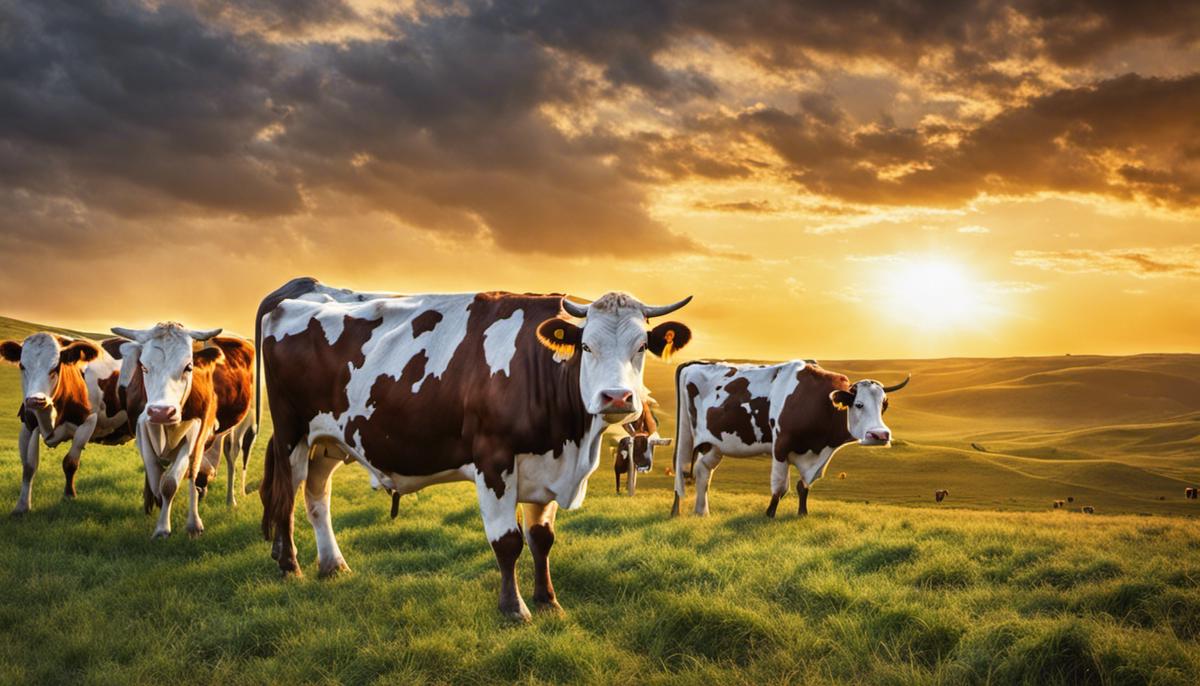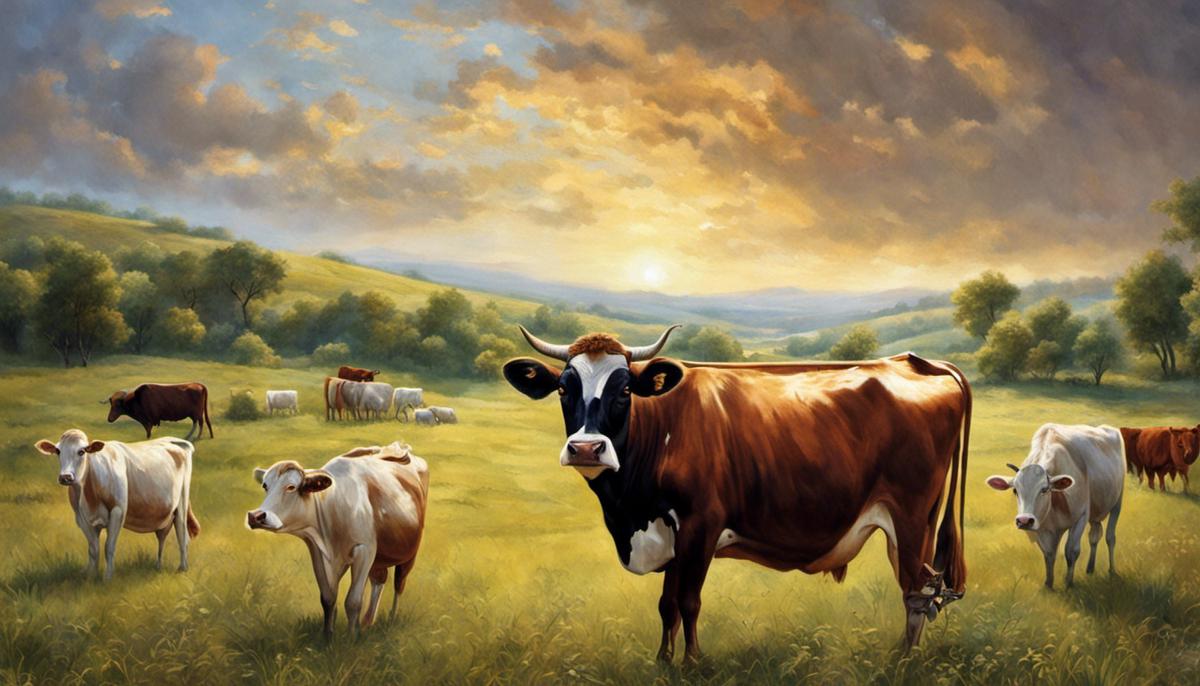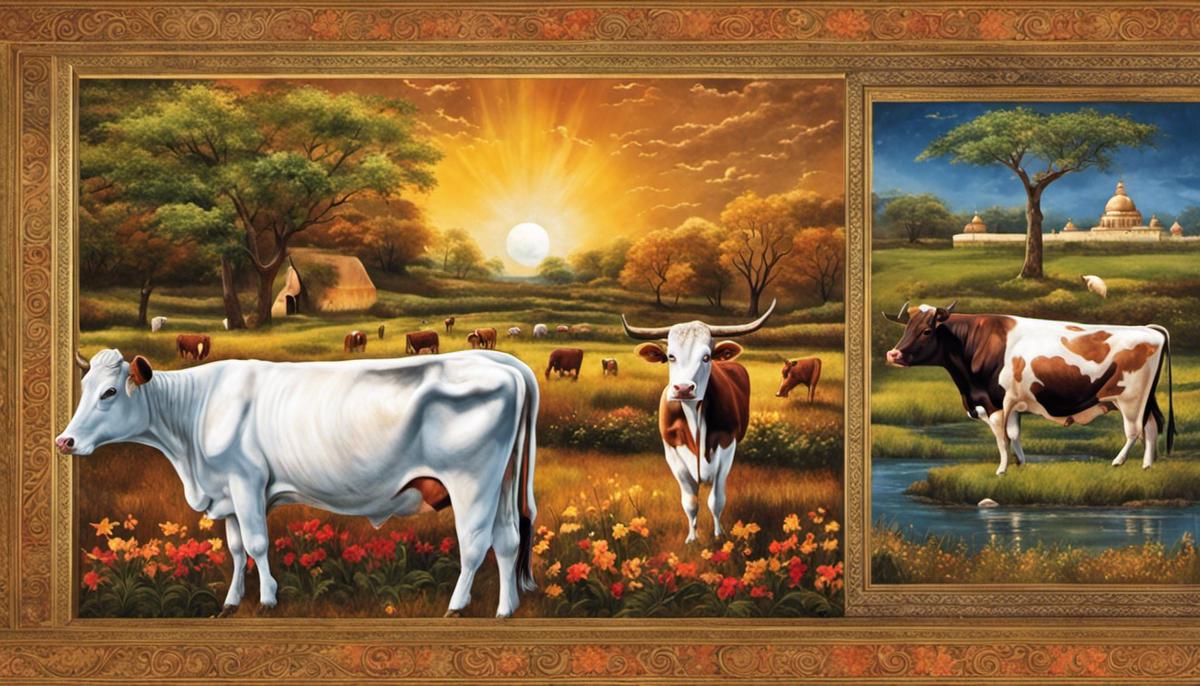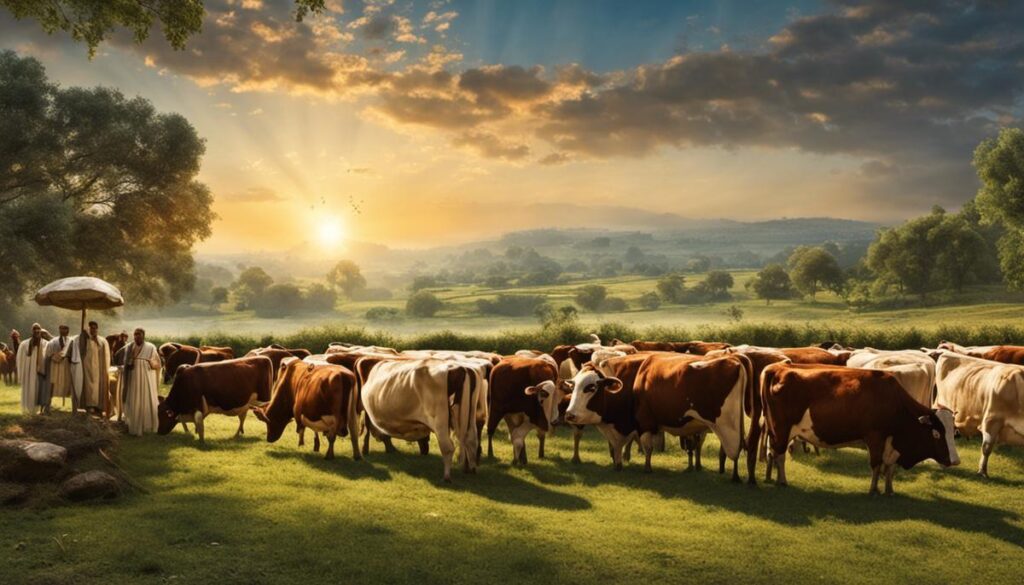Biblical symbolism offers profound insights into the human condition and the divine’s interactive role, with one of the most enduring symbols being the cow. Encased within the pages of the holy scripts, cows hold an intriguing blend of historical context and symbolism that speaks volumes about societal structures, abundances, and adversities. This discussion offers a comprehensive look at the historical role of cows in biblical societies and their symbolic significance within biblical literature. Guided by religious precedence and interpretation of scriptures, it delves deep to uncover the many layers of the theology of dreams, specifically those that feature cows.
Historical Context of Cows in the Bible
Title: Historico-Religious Implications of Cows in Biblical Texts
The ubiquitous presence of cows in historical cultures and literatures is a profound reflection of their significant roles across diverse societies. Consequently, bovine imagery permeates both sacred and secular texts, including those of biblical origins. By examining the historical contexts where cows make notable appearances in the Bible, scholars illuminate the anthropological relevance and symbolic power these animals conveyed in ancient societies.
To begin, one must highlight the Old Testament, where cows appear in narratives of grandeur and divine omen. The Seven Fat Cows and Seven Lean Cows in the Book of Genesis (Genesis 41:1-7) served as harbingers of agricultural abundance and impending famine in Egypt. This passage echoes the paramount importance of bovines in ancient agrarian societies, linking the well-being of the cows directly to the welfare of the populations they aided in sustaining.
The symbolic potency of cows extends further into religious rituals. Sacrifices of bovines were prevalent in these societies, as alluded to in sections of Leviticus and Deuteronomy. The ancient Hebrews used cows as integral components of religious ceremonies, asserting the profound relationship between deity, human, and the bovine world.
Interestingly, bovines were not merely physical entities in the Hebrew culture; they were metaphoric extensions of divine communication and prophecy. The golden calf narrative in Exodus 32 represents an apostasy from the Abrahamic God, indicating a historical struggle between monotheism and idolatry.
The Bible also presents cows as instruments in divine allegories. In Hosea 4:16, the ‘stubborn cow’ is a metaphor for the Israelites’ resistance against prophetic messages—a testament to the animal’s metaphorical dexterity in biblical literature.
Though a seemingly inconspicuous component of biblical narratives, cows also form subtle links with women’s experiences in these ancient societies. Rachael, in Genesis 30:1, equates giving birth with the reproductive abilities of bovines. This comparison not only heightens the understanding of womanhood and fertility but also underlines the multifaceted roles cows played in societal dynamism.
Beyond mere representations of wealth and agricultural prosperity, cows in the Bible engage with themes of divinity, social transgression, and cultural nuances. They emerge as literary devices intertwined with the various dimensions of life; spiritual, economic, symbolic, and social.
The examination of cows in the Bible is not merely a study of the past; it prompts contemporary reflections on how societies perceive and value life forms. The metaphorical and literal interpretations of these animals in biblical texts resonate even now, reminding us of the interconnectedness of life and literature.

Symbolic Significance of Cows in Biblical Literature
Moving on from the preceding analysis, cows in biblical literature also symbolize divine judgement, particularly accentuated in the book of Hosea. In Hosea, the eponymous prophet speaks on behalf of God against the Israelites, and, in a widely disputed passage, uses the bovine epithet to draw attention to their disobedience. Here, the bovine symbolism serves as an indictment of flagrant societal transgressions.
Cows also signify pastoral abundance and providence. In the divinely dictated dream of Pharaoh in Genesis, the fat cows that arise from the Nile are interpreted by Joseph to be seven years of abundance. Post-judgment years, represented by emaciated cows, herald famine. Such dual portrayals show cows as harbingers of both blessing and judgement, as well as denote God’s control over nature and human affairs.
Furthermore, cows play a significant role in biblical covenant rituals. Genesis provides an example when God commands Abraham to bring a three-year-old cow for covenant making. The cow is sliced in two, symbolizing how the covenant-maker will suffer a similar fate if they break their sacred obligation. Thus, cows stand as a stark reminder of how seriously these divine agreements are taken.
Cows also adopt a more subtle, physical embodiment of sacred power. The Ark of the Covenant, a sacred chest within which lie the stone tablets containing the Ten Commandments, is described to have been adorned with cherubim, often depicted as bovine creatures in ancient Near Eastern art. Yet again, this illustrates the deep-seated association of cows with the divine.
Finally, the oft-mentioned Golden Calf incident in Exodus and Kings challenges conventional bovine symbolism. When the Israelites craft and worship the Golden Calf, God’s anger highlights a noteworthy point: honoring the created above the Creator is inexcusable idolatry. The Golden Calf, thus, while originating from a revered symbol of divinity, is simultaneously a stern biblical reminder of the dangers of idolization and misplaced adoration.
In conclusion, the biblical cow is symbolic on multiple levels: as a conduit of divine messages, a sign of abundance, a participant in sacred rituals, a palpable symbol of divine wrath, and as a challenge to human propensity towards idolatry. The wide-ranging nuances of this symbolism underscore the integral presence of bovine creatures in the biblical narrative and invite renewed awareness of their cultural and spiritual significance.

Interpretations of Cows in Dreams
The interpretation of dreams involving cows, when extended into the realm of biblical symbolism, offers a wealth of insights reflective of underlying spiritual and psychological concerns. This diverse tapestry of interpretations, while highlighting the multifaceted roles of bovines in biblical narratives, inevitably grapples with complex issues of morality, faith, and divine providence.
Delving into biblical text beyond the well-known Book of Genesis, in the book of Hosea, cows take on an unusual role as symbols of divine judgement. In this prophetic book, the chastisement of Israel for their unfaithful deeds is depicted through the metaphoric use of cows. This variation reveals the flexibility of bovine symbolism in conveying divergent messages, thus underscoring the remarkable depth and complexity of biblical narratives.
Another less explored but prominent depiction of cows can be found in the representation of pastoral abundance and providence reiterated in Genesis. Here, the symbolism of cows transcends the physical realm, serving as divine signifiers hinting at God’s provision and bounty. These biblical associations, often originating from pastoral societies, echo a wider cultural appreciation for cattle as emblems of prosperity and sustenance.
Intriguingly, cows appear in less obvious biblical contexts. One such instance involves Abraham and the covenant rituals. In Genesis 15:9, a three-year-old cow becomes part of a symbolic ritual, indicating yet another layer of religious significance attributed to these animals. This extension of cow symbolism into covenant rituals reinforces their fundamental role within the religious framework and spiritual consciousness.
One cannot also overlook the compelling use of cows as physical embodiments of sacred power. This aspect of bovine symbolism comes alive in the depiction of the Ark of the Covenant, an artifact of unspeakable sacredness, adorned with cherubim possessing bovine features. This intertwining of bovine and divine, however strange it might seem, further accentuates the association of cows with the divine sphere.
The narrative of the Golden Calf provides a stark contrast to the conventional symbolism attached to bovines. Here, calf — a juvenile form of cow serves as a negative emblem resisting God’s commandments, reminding us of the perils of idolatry. This incident accentuates the nuances and contradictions inherent in biblical cow symbolism and provides a dramatic example of the use of bovines in representing spiritual struggles.
Drawing from these rich biblical narratives, interpretations of dreams involving cows can be seen as windows into our deepest spiritual concerns and moral dilemmas. The complexity and versatility of bovine symbolism in the biblical discourse paints a panoramic picture of the human story from a spiritual perspective. The multifarious roles of cows, ranging from symbols of abundance and divine judgement to reminders against idolatry, offer profound insights into human spirituality and its constant negotiation with the Divine.

The rich tapestry of biblical symbolism unravels the manifold layers of the scriptural depictions of cows, rooted deeply in the human pursuit of abundance, prosperity, and divine sign. Their symbolic resonance finds a new dimension in dreams, where their interpretations strive to weave the thread between the human experiences and the divine messages. The lens of biblical symbolism adds profound depth to our understanding of cows in dreams, hopefully providing a steering compass for the seekers who encounter this gentle creature in their symbolic slumbers. As we continue striving to deepen our understanding of such profound symbols, may we remain open to the ever-unfolding wisdom that such exploration brings.







